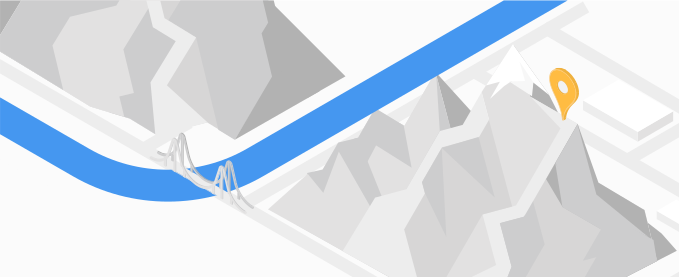
Das Elevation API ist ein Dienst, der Höhendaten für einen Standort auf der Erde oder Höhendaten entlang von Pfaden.
Vorteile der Elevation API
Mit dem Elevation API können Sie Anwendungen zur Unterstützung Ihrer Kunden mit höhenempfindlichen Aktivitäten, Positionierungsanwendungen oder wenig Vermessung die Höhen und Höhenänderungen entlang von Routen umfassen. Beispiel: können Sie Daten zu Höhenunterschieden und -verlusten bereitstellen, um eine Sport-App für Aktivitäten wie wie Wandern, Radfahren oder Tauchen.
Möglichkeiten mit der Elevation API
Mit dem Elevation API können Sie Höhendaten in Ihre oder auf einer Karte darstellen. Beispiel:
- Rufen Sie die Höhe eines bestimmten Ortes ab.
- Höhenunterschiede auf einer Route oder zwischen zwei Routen berechnen Punkte.
Funktionsweise der Elevation API
Das Elevation API akzeptiert eine Anfrage als codierte URL mit Breiten- und Längengradkoordinaten als einzelne Standorte oder als eine Reihe von Orten entlang eines Pfads angegeben werden. Diese Anfrage, z. B. fragt die Höhe für das Zentrum von Denver, Colorado, ab und gibt eine Rückgabe im JSON-Format an.https://maps.googleapis.com/maps/api/elevation/json ?locations=39.7391536%2C-104.9847034 &key=YOUR_API_KEY
Der Dienst leitet die Höhe aus den angegebenen Koordinaten ab. Außerdem interpoliert er Höhe für einen Standort ohne Höhe. Sie ergibt einen Durchschnitt, der aus den vier nächstgelegene Standorte, für die Höhendaten bereitgestellt werden. Schließlich bestimmt er die Gesamtheit Auflösung für den Standort.
Ressourcen
In der folgenden Tabelle sind die Ressourcen aufgeführt, die über die Elevation API zusammen mit den zurückgegebenen Daten an.
| Datenressourcen | Zurückgegebene Daten | Rückgabeformat |
|---|---|---|
| Koordinaten (Breiten- und Längengrad)
Sie können Daten als Gruppe mit einem oder mehreren Standorten oder als Reihe entlang eines Pfads angeben. Ich können auch codierte Koordinaten bereitstellen. Geben Sie bis zu 512 Koordinaten ein. |
Die Elevation API stellt Höhen in Metern relativ zur Verfügung. bis zum lokalen mittleren Meeresspiegel (Local Mean Sea Level, LLMSL). Die Höhe kann positiv zurückgegeben werden oder negative Werte, wie unten angegeben:
|
|
Elevation API verwenden
| 1 | Jetzt einrichten | Beginnen Sie mit Ihre Google Cloud-Projekt und schließen Sie die Einrichtung ab. befolgen Sie die Anleitung. |
| 2 | Höhenanfrage ausprobieren | Sobald Sie einen API-Schlüssel haben, können Sie die Elevation API direkt auf der in Ihrem Browser. Siehe Beispielanfragen im Startleitfaden. |
| 3 | Komplexere Anfrage erstellen | Sobald Sie ein Projekt eingerichtet haben, versuchen Sie es mit einer Anfrage, die Standortdaten entlang eines Pfad. Siehe Pfade angeben . |
| 4 | Grundlagen von Antworten | Untersuchen Sie die Antworten auf Höhendaten, um sich auf die Verwendung der Höhendaten für Ihre App vorzubereiten. Weitere Informationen finden Sie unter Antworten für die Höhe . |
| 5 | Höhendaten in die eigene App einbinden | Sie können Höhendaten verwenden, um standortbasierte Apps zu optimieren, z. B. Apps für Sport. oder für Umfragedaten. |
Verfügbare Clientbibliotheken
Rufen Sie diese API in der Sprache Ihrer Wahl über eine der folgenden Clientbibliotheken:
- Java Client für Google Maps-Dienste
- Python Client für Google Maps-Dienste
- Go-Client für Google Maps-Dienste
- Node.js Client für Google Maps-Dienste
Java-, Python-, Go- und Node.js-Client für Google Maps Dienste sind von der Community unterstützte Clientbibliotheken, die im Rahmen der Apache 2.0-Lizenz. Sie können sie von GitHub herunterladen. Dort finden Sie auch Installationsanleitungen und Beispielcode.
Nächste Schritte
- Elevation API verwenden: Gehen Sie zu Richten Sie Ihr Google Cloud-Projekt.
- Pfadbasierte Höhendaten abrufen: Gehen Sie zu Pfade angeben
- Best Practices: Gehen Sie zu Webdienst Best Practices

